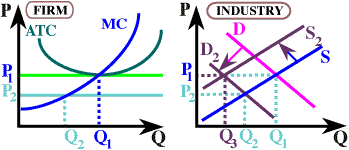As we know, losses in the industry that occurred because of the
reduction in demand will cause firms to exit the industry in the
long run. This, in turn will cause supply to shift back and market
price to rise. As long as there are losses firms will continue
to exit over the long run until profits are back to zero. The
graph below shows the new long run equilibrium.
 8. As a result of the short run effect on the wool sock industry
caused by global warming, the adjustment to long run equilibrium
will consist of:
8. As a result of the short run effect on the wool sock industry
caused by global warming, the adjustment to long run equilibrium
will consist of:
- firms entering the industry due to increased profits, shifting
the marginal and average total cost curves out until profits are
zero. There are several things wrong with this answer. First, firms
entering or leaving the industry don't shift cost curves. (In the
section on long-run supply we did consider such a case, but this
would be unlikely in general; and if it is to be considered as a possibility
on a test, there will be obvious clues in the question indicating
that this is going on.) Second, since we know the firms in the
industry were suffering short term losses, entry would not occur.
- firms leaving the industry due to losses, shifting the marginal
and average total cost curves out until profits are zero. While it is true that firms will be exiting, firms entering or
leaving the industry don't shift cost curves.
- firms leaving the industry due to losses, shifting the industry
supply curve out until prices fall enough to ensure zero profits.
Firms leaving the industry don't shift the supply curve out, they
shift it back. You must read carefully :-)
- firms leaving the industry due to losses, shifting the industry
supply curve back until prices rise enough to ensure zero profits.
- firms entering the industry due to increased profits, shifting
the supply curve out until profits are zero. This could be true if there had been an increase in demand, not a reduction, as is the case here.
Next Question
Copyright © 1995-2004 OnLineTexts.com, Inc. - All Rights Reserved

